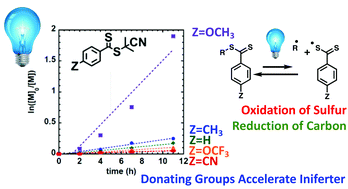Substituent effects in iniferter photopolymerization: can bond homolysis be enhanced by electronics?†
Abstract
Photoinduced-RAFT polymerization is a technique of increasing interest due to the combination of control over polymerization that RAFT processes afford with the mild reaction conditions and spatial and temporal control of photochemical processes. Iniferter RAFT polymerization is an interesting subclass of photoinduced-RAFT that eliminates the need for an added photocatalyst, as the RAFT agent is directly excited by the photon source. Iniferter RAFT is a photochemical process leading to carbon–sulfur bond homolysis. In this work we find a surprising effect of substituents on the dithiobenzoate moiety of the chain transfer agent (CTA). Donating groups dramatically accelerate the iniferter process, while withdrawing groups retard the reaction substantially. This is interpreted though electrochemistry, since homolysis of the carbon–sulfur bond is associated with a formal oxidation of the thiocarbonylthio groups and reduction of the carbon to a radical. Through this study, the unique efficiency of 2-cyano-2-propyl 4-methoxydithiobenzoate (CPMODB) as an iniferter was uncovered, as this polymerization was found to progress at a drastically enhanced rate, even when compared to similar tris[2-phenylpyridinato-C2,N]iridium(III) photocatalyzed polymerizations using an unsubstituted dithiobenzoate RAFT agent.

- This article is part of the themed collections: Polymer Chemistry Lectureship Winners and Polymer Chemistry Pioneering Investigators 2021


 Please wait while we load your content...
Please wait while we load your content...